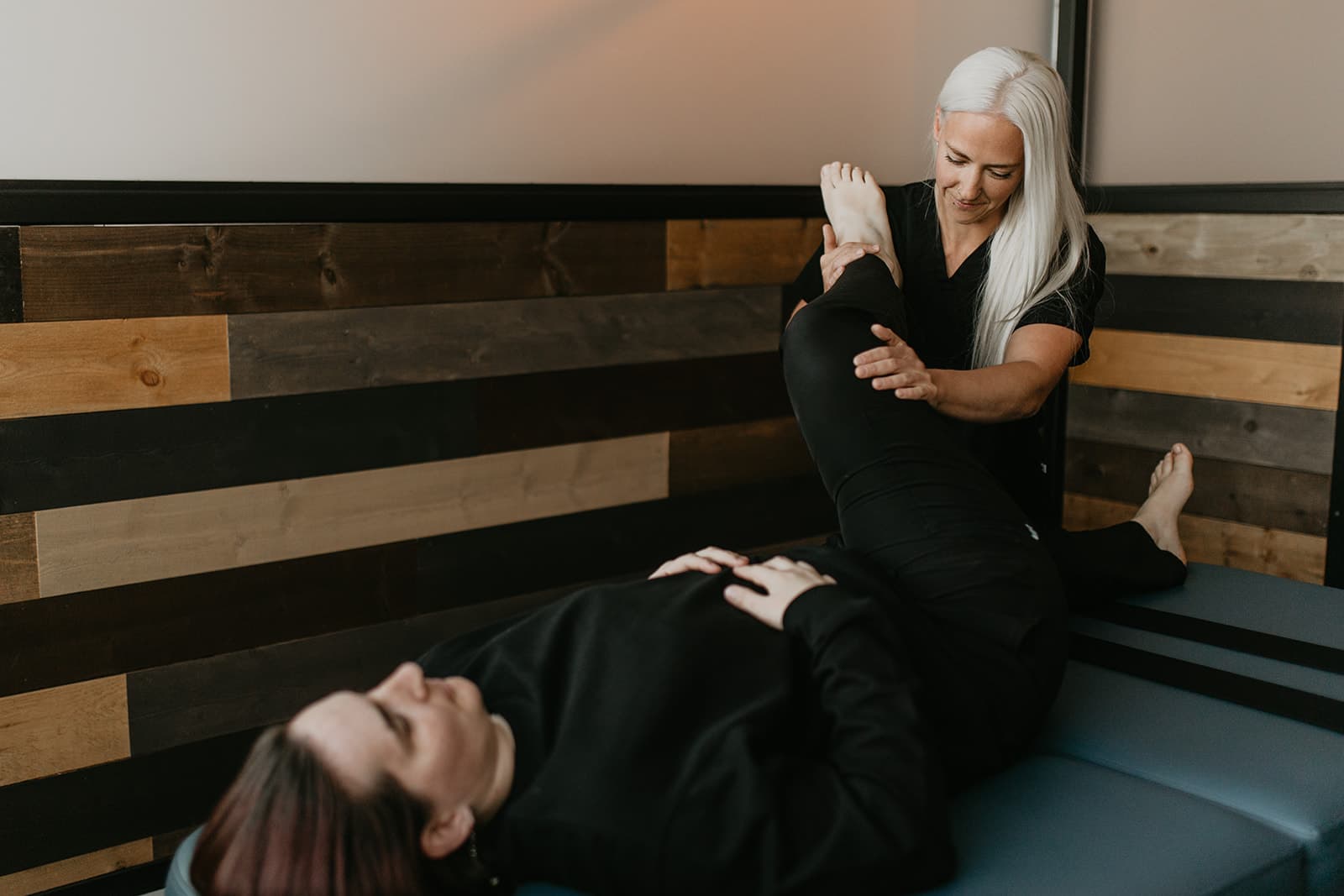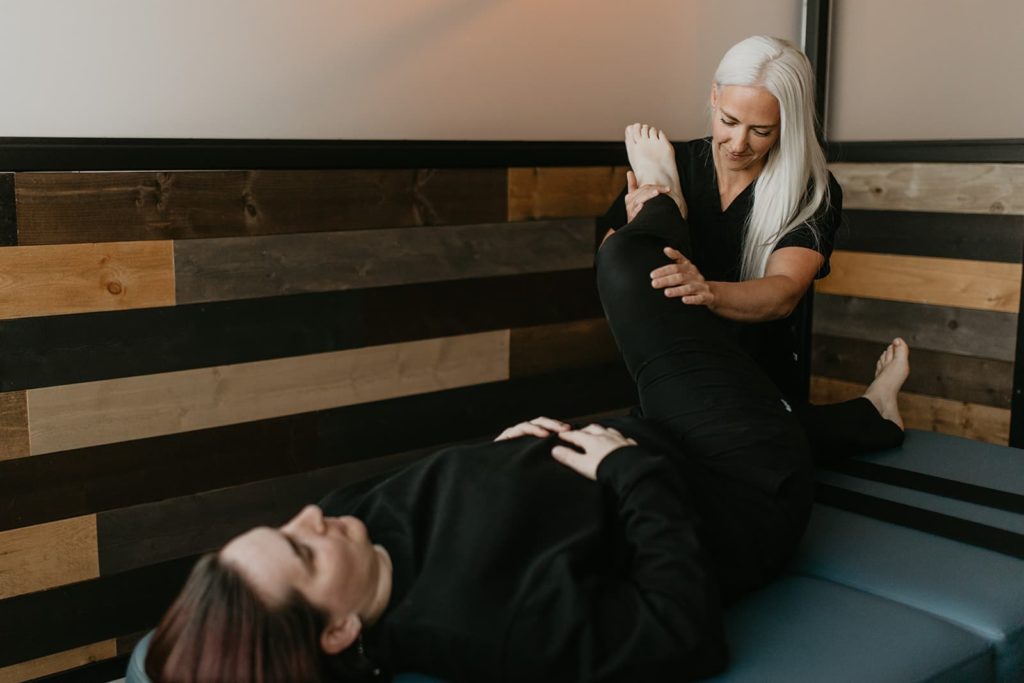When you think of stretching, the first thing that might come to mind is the importance of pre and post-workout muscle stretching for your muscles.
But have you heard about stretching your body’s connective tissue or fascia? Fascial stretch therapy (FST) is a type of physical therapy that involves stretching the fascia with the assistance of a therapist. FST can help improve flexibility, reduce muscle tension and pain, and improve the overall range of motion.
Let’s take a closer look at fascial stretch therapy, how it works, and how it can help tight hip flexors and lower back pain.
What Is Fascia?
Fascia is the connective tissue surrounding and supporting muscles, bones, and organs. It’s also believed to connect all parts of the body to provide structure and support to the body.
There are 4 main layers of fascia:
- Superficial fascia: This is right under the skin and can include muscle fibres that make up many different structures in your body
- Deep fascia: These cover bones, muscles, nerves, and blood vessels
- Visceral fascia: Is found around organs such as the lungs, heart, and stomach
- Parietal fascia: Lines a body cavity such as your pelvis
Fascia has several functions in the body depending on its location:
- Provide support and stability to surrounding tissues and organs
- Help reduce friction
- Transmit mechanical tension generated by muscular activity or external forces
When fascia is healthy, it stretches as you move. In some cases, fascia can become tight and restricted, leading to pain, stiffness, and limited mobility.
Fascia pain is sometimes mistaken for muscle or joint pain. But there is a difference: muscle and joint pain worsen as you move, and fascia pain gets better with movement. This is where fascial stretch therapy comes in.
What Is Fascial Stretch Therapy?
Fascial stretch therapy, also known as assisted stretching, involves stretching the fascia (the connective tissue surrounding muscles) with the assistance of a therapist. It’s a hands-on treatment that uses various techniques and targeted stretches with gentle force to aid recovery.
Fascial stretch therapy can help with the following:
- Tight muscles and restricted range of motion
- Chronic pain, such as lower back pain
- Postural imbalances
- Sports injuries
- Aging-related stiffness and mobility issues

Tight Hip Flexors & Lower Back Pain
Hip flexors are muscles around the top of the thighs that connect the upper leg to the hip and help you bend at the waist and raise your leg. Tight hip flexors increase your risk of injury because of the increased demand on the tissues that don’t work as they should.
You can also experience lower back pain with tight hips. Lower back pain is common with weak or unused muscles from lack of exercise, improper lifting, and poor posture.
You can get tight hips if you sit for several hours a day, go to the gym, or are a professional athlete. Fascial stretch therapy can be an effective treatment for these issues because it targets the fascia and helps with muscle tightness and pain.
During a fascial stretch therapy session, your therapist will know which areas to target to stretch the fascia and release tension in the affected muscles. They may also provide guidance on proper stretching techniques and exercises to do at home to help maintain the benefits of the therapy.
Benefits of Fascial Stretch Therapy
Fascial stretch therapy can benefit almost anyone, from professional or amateur athletes to people who work out recreationally. Your therapist can tailor a treatment plan specific to your needs.
There are several potential benefits to fascial stretch therapy:
- Improved flexibility and range of motion: Fascial stretch therapy can help loosen tight fascia and muscles to improve overall flexibility and range of motion.
- Decreased joint aches and pain: By stretching the fascia and muscles, fascial stretch therapy can help to reduce muscle tension and alleviate pain.
- Improved posture and balance: Fascial stretch therapy can help to correct postural imbalances and improve overall posture.
- Enhanced athletic performance: Improved flexibility and range of motion can help athletes perform better, reduce their risk of injury, and improve recovery.
- Stress relief: The relaxation and stretching involved in fascial stretch therapy can also help to reduce stress and promote overall relaxation and well-being.
- Increased blood flow to muscles: Stretching can relax muscles, leading to capillary expansion and increasing blood supply to the muscle cells.
Alleviate Fascial Restriction & Pain
Fascial stretch therapy can be a safe and effective way to help alleviate tight hip flexors and lower back pain to improve overall flexibility and mobility.
It’s always a good idea to consult a certified therapist to determine if fascial stretch therapy is appropriate. If you have pain, tight muscles, or an injury, contact the team at Recovery Lab and let us help you heal and move your best.



